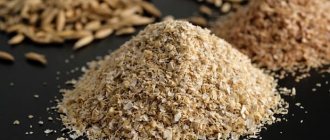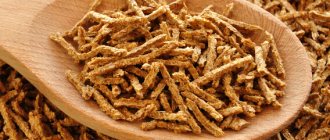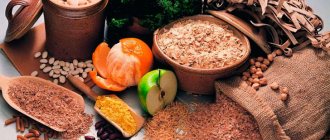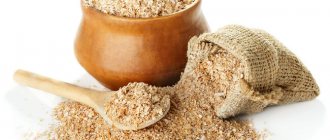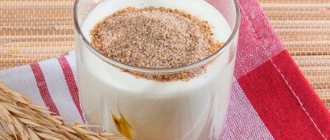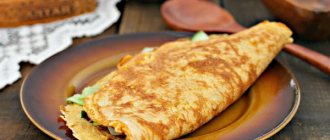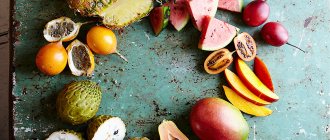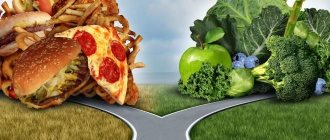Just some 30 years ago, bran was considered nothing more than animal feed. But even then, the first nutritionists and representatives of the food industry realized that this product had great potential and benefits for humans. Today, when we hear the word “bran,” we think of healthy eating, valuable fiber, and advice from a fitness trainer.
In this article we have collected the most important information about everything related to bran and the rules for their use.
What is bran
All grains undergo two types of processing aimed at removing excess. First, the husk (the so-called chaff, the inedible “wrapper” of each grain) is removed. Then the outer protective layer, which is part of the grain itself, its “skin,” is removed, resulting in producers receiving grain that is completely (or almost completely) devoid of the shell, and the byproduct of this cleaning is bran.
Bran is the hard outer layer of the grain containing various nutrients and fiber.
Why do you need to remove the shell at all if it is so rich in beneficial nutrients? The answer is simple: unprocessed grains spoil faster and acquire a bitter taste. That is, in this way manufacturers extend the shelf life of the product.
A little history
Until the twentieth century, bran in Russia (and throughout Europe) was considered about the same garbage as chaff. After cleaning, everything except the grains was usually thrown away or, at best, given as feed to domestic animals. Only towards the end of the twentieth century, nutrition researchers were able to prove that the grain shell is a valuable product that can and should be eaten. From that moment on, a new milestone began in the history of bran, marked by respect and recognition.
Chemical composition of bran
It is difficult not to recognize the value of a product that contains so many microelements, antioxidants, essential fatty acids, proteins and slow carbohydrates. The chemical composition of different types of bran can differ significantly, but almost all bran contains the following substances to one degree or another:
- vitamins of group B, as well as A, E and PP,
- calcium,
- potassium,
- phosphorus,
- iron,
- copper,
- manganese,
- zinc,
- selenium.
Nutritional value of bran
Bran varies greatly in caloric content. The “lightest” are rye (just over 100 kcal), the most nutritious are barley (over 400 kcal per 100 g).
Chemical composition of wheat bran
During the production of premium wheat flour, the waste (bran) includes: the flower shell of the grain, the aleurone layer of the endosperm and the grain germ. It is in these parts that more than 90% of the biologically valuable substances of wheat grain are concentrated (proteins, vitamins, minerals, fiber, etc.) . You can learn more about the chemical composition of bran and other parts of wheat grain in the “Old Russian Semolina” section.
When grinding wheat, the bran is separated from the rest of the grain so that the germ contained in the bran does not contribute to the rapid rancidity of the produced wheat flour, and the aleurone layer of endosperm, which has a brownish color, does not spoil its appearance.
Wheat bran is, first of all, an excellent source of fiber, essential macro- and microelements, B vitamins, vitamins E and A. Fiber is especially important for good intestinal function and the normal functioning of the digestive system as a whole. The B complex of vitamins, which wheat bran is also rich in, performs a number of important functions in the human body, namely:
- Takes an active part in carbohydrate, energy, protein, fat, water-salt metabolism, as well as in the process of hematopoiesis (vitamins B2, B3, B6 and B9 are necessary for the synthesis of hemoglobin protein, which is part of red blood cells)
- Regulates the functions of the nervous, digestive, cardiovascular and muscular systems
- Helps maintain normal hormonal balance in the human body (vitamins B3 and B6 play a critical role in the body’s production of sex hormones; vitamin B6 also takes part in the synthesis of hormones produced by the adrenal glands, thyroid gland, and pancreas)
B vitamins, like vitamins E and A, contained in wheat bran, promote rapid tissue regeneration, improve the condition of the skin, nails and hair, and are also necessary for a person to maintain excellent immunity and good vision throughout his life.
Wheat bran is also very rich in valuable macro- and microelements (for more information about the benefits of phosphorus, sulfur, copper, manganese, iodine and zinc contained in wheat grain, see the “Wheat” section of our website).
We recommend:
-0%
-0%
Lito wheat bran with milk thistle, 200 gr
Not available
Add to cart
By composition
Natural
Natural bran is a product that contains nothing but bran itself. They are good for their simplicity and are suitable for those who like to add additional flavors themselves.
With additives
Such bran may contain salt, kelp, milk thistle, vitamin complexes, particles of nuts or fruits, even spices and... pine needles. Bran with additives is very convenient to use as a base for smoothies, cocktails and breakfasts.
Bran for weight loss
One of the most popular reasons for adding bran to your diet is to lose or control weight. Bran by itself is not a “magic pill” and does not help you lose weight, but in an integrated approach to solving this issue, they provide good help.
Bran is a nourishing, but in most cases not particularly high-calorie food, which, on the one hand, helps suppress hunger for a long time, and on the other, cleanses the intestines, removing excess toxins, and normalizes its functioning. At the same time, bran contains enough useful substances that it can make up a good percentage of the daily carbohydrate requirement.
Wheat bran in baby food
If your baby is already 10 months old, you can begin to gradually introduce a decoction of wheat bran into his diet (for a small child this is an excellent vitamin and mineral food supplement). To prepare such a decoction, you need to pour boiling water over 1 teaspoon of wheat bran, cover the container with a lid and cook the bran for 12-15 minutes. Then the resulting broth must be filtered and poured into a separate container. Using a decoction of wheat bran, you can prepare soup, porridge, puree or jelly for your baby.
It is useful for children over 1 year of age to be given soups or porridges prepared with cereals pre-mixed with crushed steamed wheat bran (at the rate of 0.3 teaspoons per serving).
How to cook and eat bran
Bran tolerates heat treatment well, so you can eat it both raw and cooked.
The easiest way to introduce bran into your diet is to add it to dairy products (yogurt, kefir, fermented baked milk, matsoni). For this method, you do not need to look for a special recipe or calculate the norm in grams; just mix a few tablespoons of bran with a thick dairy product - and you will get a nutritious, complete breakfast, rich in proteins, fats and carbohydrates. As an alternative, you can take a smoothie as a basis and mix bran with the juice and pulp of fruits, vegetables, berries and herbs.
If the taste of such dishes does not seem particularly attractive to you, you should choose the second method - with heat treatment. Bran can be added to any dough of your choice - pancake, bread, buns or pancakes. Also, many housewives put bran in minced meat for cutlets, hedgehogs or meatballs. They are also very good in porridge.
Another simple and quick way to add bran to the menu is to sprinkle it on the finished salad. This is not an option for everyone and is not suitable for everyone, but it’s worth a try: maybe this is what you need? Also, some housewives like to add bran to soup (especially creamy soup).
Composition and characteristics, useful properties
Composition of wheat bran (per 100 g):
- proteins – 16 g;
- water – up to 15 g;
- dietary fiber – 43 g;
- fats – up to 4 g;
- carbohydrates – up to 20 g;
- ash – up to 6 g.
The energy value is 160 kcal/100 grams.
Note that the daily dose can range from 5 to 30 grams of the product, so the risk of gaining extra pounds is eliminated. On the contrary, wheat bran promotes weight loss and is recommended to be included in weight loss diets.
The product “works” in the body as a cleansing detox complex:
- Fiber fills the stomach and promotes quick satiety. Dietary fiber cleanses the intestinal walls and helps gently relieve constipation;
- Wheat bran, taken with liquid, swells in the stomach and intestines and acts as an absorbent. The product absorbs toxins, neutralizes harmful substances, reduces the risks of toxicity to the body;
- Omega 3 and Omega 6 acids included in the composition help the functioning of the cardiovascular system and prevent the formation of atherosclerosis;
- Regular consumption has a positive effect on the functioning of the entire body, reduces excess weight: bran contains B vitamins and microelements (potassium, phosphorus, calcium, selenium, iron, magnesium, zinc).
The beneficial properties of wheat grain shells have led to their use for the treatment and prevention of diseases and healing of the body. By following the advice of nutritionists and including a natural product in your diet, you will immediately see the results:
- digestion improves. Dietary fiber, entering the intestines, absorbs harmful substances like a sponge. By swelling, it dilutes feces, which normalizes daily stool;
- the risk of cancer is reduced. Wheat bran, gently cleansing the intestines and removing toxins, effectively protects the body from colon cancer;
- the functioning of the circulatory system improves. A complex of fiber and vitamins reduces cholesterol levels and improves the functioning of the cardiovascular system. The use of bran is an excellent prevention of tachycardia, ischemia, arrhythmia, atherosclerosis;
- Excess weight goes away. By properly building a diet and including this remedy in your daily diet, you will achieve rapid weight loss. The product, swelling in the stomach, creates volume and prevents overeating.
In addition, doctors recommend using the product for sexual problems in men and women. This will allow you to prolong your active sex life and protect against the development of mastopathy in women and prostate cancer in men.
Recently, wheat, rye and oat bran have become very popular among people leading a healthy lifestyle. We will tell you further about how to use this product at home.
In home cooking. How to take it correctly?
You can now buy delicious and healthy bran bread in stores. Bran is also used for home baking: it is added to buns, flatbreads, cookies, and pies.
But not everyone knows that wheat casings can diversify the home menu. For example, they are added to oatmeal, soups, stews, and meat dishes.
When making cutlets, you can mix minced meat and a small amount of bran. These steamed cutlets will be an excellent component of a diet menu.
By the way, minced meat for cutlets can be not only meat, but also vegetarian: from cabbage, carrots, beets.
For readers who want to diversify their snacks in the office or in class, we offer a recipe for delicious bars made from nuts, honey, bran and dried fruits:
Mix chopped dried fruits (dried apricots, prunes, raisins, figs) with chopped walnuts (3 pcs) in a bowl. Add two tablespoons of wheat bran and three tablespoons of honey to the resulting mixture (200 grams). Mix everything thoroughly. Form bars and pack them in cling film and store in the refrigerator.
In folk medicine
For general health improvement and prevention of obesity, bran is taken in the form of an infusion or decoction.
- To normalize the functioning of the gastrointestinal tract, you need to prepare an infusion of 1 glass of shells and a liter of boiled water. The mixture is infused for 8 hours, filtered, a little honey (1-2 tablespoons) is added, and taken throughout the day.
- To strengthen the immune system and general health, prepare a decoction of 1 tbsp. spoons of wheat shells and 2 cups of boiling water. The mixture is boiled for 30-40 minutes. The decoction is drunk warm three to four times a day, with a small amount of honey.
- To treat bronchitis, a hot decoction of grain shells is used. Add 400 grams of washed bran to a saucepan with 1.5 liters of boiling water. The mixture is boiled for 30 minutes, filtered and poured into a thermos. Drink instead of tea, several times a day.
In cosmetology
Natural cosmetics are expensive. But if you know about the properties of wheat bran and use them correctly at home, you can get excellent results and at the same time significantly save your budget.
First of all, let us note the benefits of wheat shells for cleansing the skin of the face and body. By including this product in your peeling, you will gently cleanse your pores, exfoliate your skin and give it a healthy, radiant look.
The simplest peeling mask for normal skin consists of 3 tablespoons of water and 1 tablespoon of bran. Mix the ingredients in a glass bowl, apply to the face and neck, massage gently and rinse with warm water.
To whiten the skin, use wheat bran, cream (or yogurt) and lemon juice. This is an effective remedy for combating age-related skin pigmentation.
Mix 1 teaspoon of bran with 3 tablespoons of yogurt and lemon juice (1 teaspoon). If your skin is dry, replace yogurt with cream or sour cream. Apply the mask to your face and neck, rinse with water after 15 minutes.
A mask of bran, honey and cream not only improves complexion, but also significantly increases skin elasticity. Therefore, cosmetologists recommend it as an anti-age product. The composition is simple: one tablespoon of each component is mixed in a bowl, then applied to the face, lightly rubbing into the skin. After 15 minutes, remove, rinse the skin with warm water and wipe with tonic.
For weight loss
We have already noted the benefits of wheat bran in the fight against excess weight. This product in the diet of a person losing weight will help speed up the metabolic process and will work as a “cleaner” of the body.
To achieve a quick effect, nutritionists recommend consuming bran separately from other products. Effective and simple way:
ü 1 tablespoon of grain shells is poured with a cup of warm water and left for a while. The mixture should be taken before meals (15 minutes before) and washed down with enough water.
This technique will allow you to quickly lose weight and cleanse the body of toxins: the swollen bran will fill the stomach and protect against overeating. Once in the intestines, the bran will cleanse the walls of toxins and harmful food residues.
Here are some more tips for losing weight:
- For an office snack, mix bran and yogurt. You can add pieces of dried fruits and nuts to the mixture.
- brew a healthy drink: add 2 tbsp to boiling water (1 liter). spoons of bran, cook for 15 minutes, strain and take before meals.
- For dinner, prepare a dish of low-fat cottage cheese and bran. You can top it with yogurt and fresh berries.
During pregnancy and breastfeeding
Pregnant and lactating women should carefully choose foods for their diet. It is necessary to ensure a balance between vitamins and calories. In this case, wheat bran will be an excellent addition to the diet:
- promote proper bowel function and prevent constipation;
- provide the body with B vitamins;
- protect against dysbacteriosis.
Contraindications for use may be individual intolerance to the product.
How to select and store bran
When choosing bran, give preference not to beautiful packaging, but to the date of manufacture: the fresher the bran, the more useful substances are preserved in it. Yes, over time (and especially when in contact with oxygen), bran loses its valuable properties, in addition, small insects that tend to live in homemade cereals are very fond of them. That is why bran should be stored in an airtight container and, best of all, in the refrigerator.
If you buy bran at a low price, make sure that it does not contain large coarse particles that will be difficult to digest. Nutritionists believe that finely ground bran is good for the stomach, and coarse bran is good for the intestines. When purchasing bran with additives, make sure that the composition does not contain flavor enhancers, flavorings, dyes or preservatives.
Before actively introducing bran into your diet, please consult your physician, especially if you have any contraindications.
Harm and contraindications
Like any other product, bran has a number of contraindications:
- stomach and duodenal ulcers;
- rehabilitation period after a serious illness or surgery. Due to bran, the body will receive less nutrients.
Excessive consumption of the product may cause constipation and indigestion.
Important! Children under 12 years of age should not be given bran: the product is quite difficult for the body to absorb, so the child may experience prolonged constipation and bloating.
Contain gluten
Approximately 1% of the world's population suffers from celiac disease (gluten intolerance). In such people, gluten damages the intestinal villi, which leads to digestive disorders (nausea, diarrhea, vomiting). If you are gluten intolerant, you should avoid eating waste products.
Contains fructans
Wheat bran contains fructans, which release large amounts of gas when digested in the colon. This leads to the development of unpleasant symptoms such as belching, bloating and irritable bowel syndrome.
Phytic acid
Phytic acid is a substance that has a positive effect on the body, reducing the risk of developing breast cancer in women. This happens due to the fact that phytic acid binds estrogens circulating in the blood and removes them through the intestines. However, phytic acid also has another property: it removes valuable microelements from the body, which can cause iron deficiency anemia, increased fragility of bone tissue, etc.
Important! Heat treatment neutralizes the effect of phytic acid. Therefore, if you use bran as an additional ingredient for baking, microelements will be absorbed in full.
